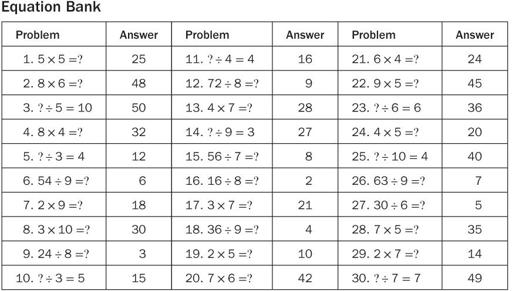Teaching the Common Core Math Standards With Hands-On Activities, Grades 3-5 (4 page)
Read Teaching the Common Core Math Standards With Hands-On Activities, Grades 3-5 Online
Authors: Judith A. Muschla,Gary Robert Muschla,Erin Muschla-Berry
Tags: #Education, #Teaching Methods & Materials, #Mathematics, #General

“Represent and solve problems involving multiplication and division.”
4. “Determine the unknown whole number in a multiplication or division equation relating three whole numbers.”
Background
To find the missing number in a multiplication or division equation, students should know their basic facts. For example, knowing that is necessary to find the missing number in equations such as
is necessary to find the missing number in equations such as and
and
Activity: Equation Tic-Tac-Toe
In a twist on the traditional game of tic-tac-toe, students will complete tic-tac-toe boards by randomly choosing and writing nine numbers from 1 to 50 on their boards. After the boards are completed, the teacher presents an equation to the class. If the answer to the equation is on a student's board, the student writes an X over it. The first person who gets three Xs in a row or along a diagonal wins. If no student gets three Xs in a row or along a diagonal, the student who has the most Xs after completing all of the equations is the winner.
Materials
One sheet of unlined paper for each student.
Procedure
1.
Explain that students will play equation tic-tac-toe, but note that this is a little different from the standard game of tic-tac-toe. In this game, each student has his or her own board and everyone plays against everyone else at the same time.
2.
Distribute the paper. (If you are considering playing more than one round, you might have your students fold their papers in half from top to bottom. Using the front and back of the paper results in four regions, each of which can easily accommodate one tic-tac-toe board. It is likely that you will need to create more equations to play more games.) Instruct your students to draw a tic-tac-toe board on (each region of) their papers as shown.
3.
Explain to your students that they are to select any nine numbers from the numbers 1 through 50 and write one number in each space on the tic-tac-toe board. Note that they cannot use any number more than once.
4.
Explain that you will present an equation. Students who have the answer on their boards should place an X over the number. There are two ways to win. The first student to get three Xs in a row or along a diagonal wins. If all of the equations have been presented, and no one has three Xs in a row, the student with the most Xs on his or her board is the winner.
5.
Begin the game. Present the first equation from the Equation Bank, and continue until someone wins or all of the equations have been used.
Closure
Review the answers after each game to verify the winner. Create equations of your own to play additional games.
Operations and Algebraic Thinking: 3.OA.5
“Understand properties of multiplication and the relationship between multiplication and division.”
5. “Apply properties of operations as strategies to multiply and divide.”
Background
Applying mathematical properties can help students compute by changing the order of factors, grouping factors, and expressing a factor as the sum of two numbers.
- The commutative property of multiplication,
 states that the order of multiplying two factors does not affect their product.
states that the order of multiplying two factors does not affect their product. - The associative property of multiplication,
 states that the order of grouping factors does not affect their product.
states that the order of grouping factors does not affect their product. - The distributive property,
 states that the product of a factor and a sum is equal to multiplying each addend in the sum by the factor and then adding the products.
states that the product of a factor and a sum is equal to multiplying each addend in the sum by the factor and then adding the products.
Although students need not know the names of these properties to complete this activity, an intuitive grasp of the properties will be helpful.
Activity: Applying Properties
Working in pairs or groups of three, students will apply properties of operations to complete math equations.
Materials
Scissors; one copy of reproducible, “Fact Cards,” for each pair or group of students.
Procedure
1.
Hand out copies of the reproducible. Explain to your students that the reproducible contains 20 fact cards. Each card is equivalent to 1 of 4 different values.
2.
Explain that students are to cut out the cards. They are then to place each card with the other cards that have the same value. (
Note:
They should finish with four sets of cards, though not all sets will have the same number of cards.)
Closure
Check students' results. Ask your students to share strategies they used to arrange their cards correctly. Emphasize that problems can often be solved in different ways.
Answers


